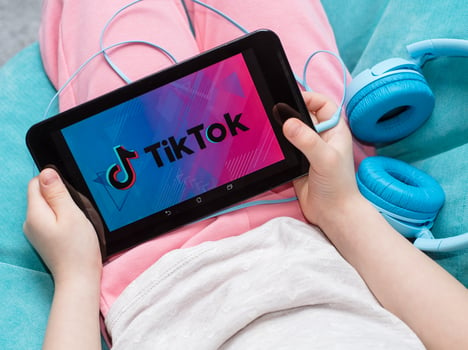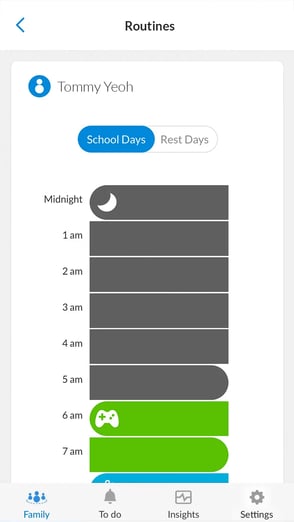TikTok Safety In Schools: An Online Guide for Educators & Parents
By: Sam Cortez
Updated: 03 November, 2024
Last week, a viral school threat circulated on TikTok, warning students that several mass shootings would occur in schools across the country on December 17th. The widespread alert put the social media platform at the center of scrutiny surrounding safety concerns for young users once again.
Although some schools were threatened specifically, the viral message was aimed at the general K-12 population. As a result, several districts in the United States closed schools for the day; other schools heightened security and warned parents.
While no shootings occurred surrounding this incident, in spite of what this viral threat predicted, arrests were made in several states including Florida, Maryland, Connecticut, and California.
According to cyber safety and digital wellness expert Teodora Pavkovic, TikTok became the most important platform for educators and parents to keep an eye on in 2021, and this is unlikely to change in 2022.
"Nearly 50% of TikTok's users in the United States are aged 10-29, and it's the place they go to to find everything from humorous videos to the definition of mental illness," Pavkovic says. "With such a wide range of online behaviors playing out on a platform that has been optimized for global trends, we can expect a whole range of content going viral in the near future."
This most recent incident highlights the greater threat that TikTok can pose to student safety, education, and digital wellness in schools around the world.
Underage users on TikTok
TikTok has a history of struggling to maintain its control over and privacy of underage users. Back in 2019, TikTok paid a $5.7 million fine to the Federal Trade Commission to settle accusations that the company was illegally collecting personal information from underage users. 
Furthermore, although TikTok’s terms and conditions state that users must be at least 13 years of age to join the platform, current and former employees at the company told the New York Times that a third of its entire user base is under 14.
Because there is no way to verify an individual’s birth date, many users simply lie about their age during the signup process. In July 2021, TikTok deleted just over seven million accounts that it suspected belonged to underage users.
New TikTok rules for users 16 and younger
To make TikTok safer and gain better control over age-restricted app usage, TikTok has implemented several policies that alter in-app permissions depending on the user’s age bracket. Here’s how it breaks down:
-
With the new TikTok Younger Users feature, users under 13 can't post videos or comment, but they can view content that is personalized for a younger audience (only available in the US).
-
Teens between the ages of 13 to 15 can have accounts that are set to private by default, and only friends can comment on their videos. Certain popular features, like “Duets” and “Stitching,” can only be used with friends.
-
Users who are at least 16 can livestream and use direct messaging, as well as TikTok video features.
Privacy concerns on TikTok
Privacy has long been a concern surrounding TikTok usage (and other social platforms, too). In addition to the nearly $6 million TikTok paid to the FTC, Anne Longfield, the former children's commissioner for England, is reportedly suing TikTok for billions of dollars on behalf of children in the UK and EU.
The lawsuit alleges that TikTok continues to collect personal information from children, including phone numbers, location, and biometric data, without parental consent.
Each piece of data is stored somewhere; how secure that storage is, how long it remains collected (even after deleting an account) and how that data is used is rarely communicated in a clear and transparent way.
Predatory behavior on TikTok
Privacy complications extend far beyond collecting user data from children; protection from child predators is also a crucial concern.
A BBC investigation found that underage users were exposed to hundreds of predatory messages from predatory strangers intent on grooming young users.
As a result, authorities around the world have conducted their own investigations in an effort to ensure TikTok is no longer a hospitable environment for predators. Additionally, many TikTok users have also taken a DIY approach to monitoring predatory behavior on the app by collecting and sharing screenshots of sexual misconduct in an effort to warn others and alert authorities.
While TikTok’s own reporting feature has often been criticized for its [lack of] efficacy, it is still important for educators, parents and students to be aware of it and to actively use it to report any inappropriate or distressing content.
Cyberbullying on TikTok
As the platform of choice for Gen-Zers, TikTok has become a hub for online bullying; body shaming is particularly prevalent on TikTok. This type of psychological abuse is harmful to young, impressionable minds whose early experiences will continue to shape their sense of self-worth, and can help to further perpetuate unhealthy societal norms from early on.
In March 2021, TikTok partnered with the Cyberbullying Research Center to help develop initiatives that prevent cyberbullying and harassment on the platform. New features designed to curb online bullying include:
-
The ability to review comments before they appear alongside videos
-
An AI-powered anti-bullying coach that flags potentially harmful content and gives the commenter the chance to re-think and edit their post
-
A spam filter that removes comments with offensive language and keywords
TikTok school challenges
TikTok challenges encourage students to participate in risky and harmful activities and share them on their profiles for clout.
The “Devious Licks” challenge became one of the most popular ones in 2021, where students filmed themselves vandalizing or stealing items from school property. Through the challenge, students stole items including soap dispensers, fire extinguishers, microscopes, and SMART boards. Several students who were identified in their videos were later charged with theft, criminal mischief, and vandalism.

TikTok responded to the #DeviousLicks challenge by redirecting the hashtag and removing any related content from its search results. The users themselves responded by quickly coming up with an alternative hashtag, #dispicablelicks.
This illustrates perfectly just how quickly trends spread and evolve on TikTok, and why it’s so important for educators to stay informed, to educate their districts, and respond to social media trends quickly with best TikTok safety practices in mind.
How schools should treat TikTok threats and challenges
School districts are in the best position to protect their students, staff, and property, and preserve the harmony within their community. Today, social media dominates so much of our children’s lives, and because they spend the larger portion of their day in school, it’s up to school administrators to ensure safety both on and offline.
Stay informed
Staff don’t have to be active TikTok users to leverage the platform as an investigative and informative tool. A staff member(s) should monitor the platform regularly: Pay attention to trending hashtags, popular challenges, and local content. This way, you can pinpoint potential problems long before they become a serious issue.
"If you do come upon trends that worry you and seem likely to impact your district imminently, remember to keep your own internal communication about this off social media," Pavkovic points out. "If you want to get this information to your staff and parents, use other forms of communication, like phone calls, texts or email, to avoid amplifying the very trend you are wanting to control or avoid entirely."
Monitor students
Teachers should monitor students in two key ways: via school technology as well as direct observation.
Part of staying informed means monitoring your students’ devices and recognizing red flags when it comes to online behaviors. In today’s educational environment, 1:1 learning is common, and your staff needs to be equipped with the right tools to monitor students safely and effectively.
Check out how Linewize Monitor empowers your entire school community and helps your students stay safe on their digital journeys.
Many schools already have filtering and monitoring solutions in place to maintain compliance; however, filtering and monitoring are about much more than blocking violent and adult content.
When used correctly, these tools empower teachers by providing them with holistic insights into their students’ behavior. Simply put: the right monitoring and filtering solutions can help educators intervene when it matters most.
Educate parents
Teachers are in a unique position to observe the development of social media trends within their schools in real-time, and should use that insight to help parents stay informed as well. Now more than ever, it’s important for parents to understand how their kids are using social media, and the impact it has on their personal and academic lives.
There are two primary ways to support parents: First, provide them with access to parental control tools, and secondly, provide them with education, resources and advice on how to help their children use social media and gaming technologies in more intentional, positive and responsible ways.
Provide parents with simple and helpful technology

Parents need access to cutting edge technology that allows them to have useful insights, apply appropriate filters, and easily control their children’s Internet usage. Qustodio's parental control app allows parents to manage screen time, limit social media, set bed and study times, and block specific types of content.
Meanwhile, the Linewize Community program provides parents access to their own district’s custom-made Online Safety Hub, the central location for advice and support regarding topics like cyberbullying, getting your child their first smartphone, and making social media platforms safer for teenagers.
In addition, the Hub houses a continually updated library of 200+ app and game reviews, helping parents make more informed decisions about where their children spend their time online.
Learn more about how the Linewize Community program supports school districts with expert-backed resources, online activity reporting, live parent-focused webinars, and much more.
Provide parents with empowering education on cyber safety
TikTok isn’t inherently a bad digital space for young people; many students have used TikTok to spread messages around social activism, break social barriers, and discuss important topics, like climate change. The issue isn’t only to do with the platform itself, but with how it’s used as well.
Younger teenagers, aged 13 and above, can still use the app safely, as long as it's scaffolded with proper adult supervision. When monitored and used correctly, students can have a fun—and even educational—experience on TikTok. However, combining at-home monitoring with conversation is essential.
“Using monitoring software alone doesn’t amount to much more than surveillance,” cautions Teodora. “When you add conversation to that—and lots of it—you create that vital dialogue around digital citizenship, healthy online habits, and social-emotional well-being. Parental controls and apps absolutely must be paired with conversations about why those filters are in place, and what kinds of behaviors on your child’s part will gradually lead to a reduction in those filters and other limits.”
Furthermore, it’s important to understand how each individual user impacts the ebb and flow of TikTok trends. According to Pavkovic, this is the greatest challenge when it comes to staying safe on social media platforms that are entirely made up of user-generated content.
“An important best practice to follow is not to continue the spread of any harmful user-generated content via social media,” Pavkovic adds. “One of the biggest issues with TikTok’s recent viral trend of school threats was that, in an attempt to caution and potentially protect others, users continued sharing the news, which only helped the trend go viral. TikTok’s algorithm doesn't distinguish between users who are sharing content out of concern or curiosity and those who are doing so out of spite or malice. A share is a share in the online world.”
Educate students
TikTok’s bandwagon effect has made many students feel invincible; they falsely believe that they can participate in online challenges without facing consequences in real life, because if everyone else is doing it, no one will get in trouble. This is what psychologists refer to as the “diffusion of responsibility” phenomenon.
Educators should remind their students that this isn’t the case and that, in lieu of recent threats and challenges, administrators will be taking more serious actions against individuals who violate school rules. So, if TikTok and other social media channels aren’t a priority for your district’s staff right now, it would be best to reorient your position as soon as possible.
“I would strongly encourage districts to develop or update their policy around communicating with parents when there is evidence of students’ problematic use of school-issued or personal devices,” says Pavkovic. “Schools need to establish a set of criteria and, ideally, designate one or more staff members to be in charge of communicating with parents regarding these sensitive topics. This could be a counselor, a social-emotional learning coach, a PTA representative or a student safety expert.”
Once you are done finalizing your policies and code of conduct, communicate them via a school assembly, homeroom announcement, parent form and signature, and/or any other medium you deem appropriate, making sure that your parent community is in alignment with your expectations around student behavior.
Embrace social media awareness
TikTok doesn’t have to be the enemy, at home or inside the classroom. Teachers around the world have found ways of combating their own negativity biases towards the platform, embracing it instead and incorporating it into their lesson plans.
As a part of your duty to “Stay Informed,” it’s important for your teachers to educate themselves on how TikTok works and how young people are utilizing it in their daily life. Talk to your students about the platform, and about what’s happening on social media on a regular basis.
For instance, many teachers hold a “current events” discussion as a part of their curriculum; with technology, social media, and education being so intertwined in today’s learning environment, staff should consider starting a dialogue around what’s happening on social media today and how it impacts student lives and their well-being.
Linewize’s School Manager helps districts maintain compliance, minimizes admin workload, and provides teachers with a safe platform for managing their lesson plans autonomously.
According to Pavkovic: “We all have a part to play in keeping each other safe online, and we all— the older generations in particular—have a lot to learn about how to do this.” It’s important for educators to remember that, and maintain a neutral tone when delivering social media education to their students.
Pavkovic adds: “It’s not about teachers saying ‘let me tell you what you need to do because I know how to keep everyone safe.’ Instead, it’s about admitting that, ‘this is all still very new to me too, and I don’t yet know the perfect solution, or if there even is one. It’s scary and confusing, but we are all in this together.’”
In an effort to embrace social media, it’s been encouraging to see an increasing number of teachers become willing to meet their students where they are. Initiating discussions about social media from a current events perspective will allow these young people to broaden their perspective and become more self-aware in the long-run.
Best practices for safe social media use
There is a huge volume of information out there on helping students use TikTok safely, and learning how to navigate different social media platforms can be exhausting. The following is a summary of best practices for safe social media use, but it’s important to consider how your students and wider community influence the way you communicate and implement these safety tips:
-
Don’t continue sharing harmful content on social media, even if to warn others
-
Elevate your social media literacy by always questioning the source of any post or trend—especially on platforms with user-generated content
-
Have a policy in place that instructs staff, parents and students on how to quickly and safely report potentially harmful social media content
-
Communicate your policy clearly to students, staff, and parents
-
Equip parents with tools to monitor their children, and resources to help guide and educate them
-
Ensure your school’s filtering and monitoring tools are up-to-date, and that they can safely and effectively monitor students’ online behavior
-
Embrace social media awareness by incorporating social media conversation-starters into lesson plans and/or at-home discussions
-
Talk to children about social media and give them the opportunity to voice their opinions and concerns
-
Teach your students about good digital citizenship and social responsibility
Parents: For more information on social responsibility, check out this article on how to teach your children good digital citizenship.
Let's connect
Talk to us
Talk to an expert or book a demo. Our cyber safety experts are waiting to help.
Stay in touch
Sign up for our newsletter to get all the latest product information.

